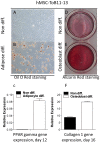Separate developmental programs for HLA-A and -B cell surface expression during differentiation from embryonic stem cells to lymphocytes, adipocytes and osteoblasts
- PMID: 23349864
- PMCID: PMC3548781
- DOI: 10.1371/journal.pone.0054366
Separate developmental programs for HLA-A and -B cell surface expression during differentiation from embryonic stem cells to lymphocytes, adipocytes and osteoblasts
Abstract
A major problem of allogeneic stem cell therapy is immunologically mediated graft rejection. HLA class I A, B, and Cw antigens are crucial factors, but little is known of their respective expression on stem cells and their progenies. We have recently shown that locus-specific expression (HLA-A, but not -B) is seen on some multipotent stem cells, and this raises the question how this is in other stem cells and how it changes during differentiation. In this study, we have used flow cytometry to investigate the cell surface expression of HLA-A and -B on human embryonic stem cells (hESC), human hematopoietic stem cells (hHSC), human mesenchymal stem cells (hMSC) and their fully-differentiated progenies such as lymphocytes, adipocytes and osteoblasts. hESC showed extremely low levels of HLA-A and no -B. In contrast, multipotent hMSC and hHSC generally expressed higher levels of HLA-A and clearly HLA-B though at lower levels. IFNγ induced HLA-A to very high levels on both hESC and hMSC and HLA-B on hMSC. Even on hESC, a low expression of HLA-B was achieved. Differentiation of hMSC to osteoblasts downregulated HLA-A expression (P = 0.017). Interestingly HLA class I on T lymphocytes differed between different compartments. Mature bone marrow CD4(+) and CD8(+) T cells expressed similar HLA-A and -B levels as hHSC, while in the peripheral blood they expressed significantly more HLA-B7 (P = 0.0007 and P = 0.004 for CD4(+) and CD8(+) T cells, respectively). Thus different HLA loci are differentially regulated during differentiation of stem cells.
Conflict of interest statement
Figures





Similar articles
-
Impaired cell surface expression of HLA-B antigens on mesenchymal stem cells and muscle cell progenitors.PLoS One. 2010 May 28;5(5):e10900. doi: 10.1371/journal.pone.0010900. PLoS One. 2010. PMID: 20531935 Free PMC article.
-
Regulation of human skeletal stem cells differentiation by Dlk1/Pref-1.J Bone Miner Res. 2004 May;19(5):841-52. doi: 10.1359/JBMR.040118. Epub 2004 Jan 19. J Bone Miner Res. 2004. PMID: 15068508
-
Preferential expansion of human umbilical cord blood-derived CD34-positive cells on major histocompatibility complex-matched amnion-derived mesenchymal stem cells.Haematologica. 2009 May;94(5):618-28. doi: 10.3324/haematol.2008.004705. Epub 2009 Mar 31. Haematologica. 2009. PMID: 19336739 Free PMC article.
-
Long Noncoding RNA: Function and Mechanism on Differentiation of Mesenchymal Stem Cells and Embryonic Stem Cells.Curr Stem Cell Res Ther. 2019;14(3):259-267. doi: 10.2174/1574888X14666181127145809. Curr Stem Cell Res Ther. 2019. PMID: 30479219 Review.
-
Signal transduction and transcriptional regulation during mesenchymal cell differentiation.J Bone Miner Metab. 2008;26(3):203-12. doi: 10.1007/s00774-007-0824-2. Epub 2008 May 11. J Bone Miner Metab. 2008. PMID: 18470659 Review. No abstract available.
Cited by
-
Maintenance of Hypoimmunogenic Features via Regulation of Endogenous Antigen Processing and Presentation Machinery.Front Bioeng Biotechnol. 2022 Jul 22;10:936584. doi: 10.3389/fbioe.2022.936584. eCollection 2022. Front Bioeng Biotechnol. 2022. PMID: 36032723 Free PMC article.
-
A proteomics approach to study mouse long bones: examining baseline differences and mechanical loading-induced bone formation in young-adult and old mice.Aging (Albany NY). 2024 Oct 12;16(19):12726-12768. doi: 10.18632/aging.206131. Epub 2024 Oct 12. Aging (Albany NY). 2024. PMID: 39400554 Free PMC article.
-
Maresin-1 and Resolvin E1 Promote Regenerative Properties of Periodontal Ligament Stem Cells Under Inflammatory Conditions.Front Immunol. 2020 Sep 25;11:585530. doi: 10.3389/fimmu.2020.585530. eCollection 2020. Front Immunol. 2020. PMID: 33101318 Free PMC article.
-
Cell surface expression level variation between two common Human Leukocyte Antigen alleles, HLA-A2 and HLA-B8, is dependent on the structure of the C terminal part of the alpha 2 and the alpha 3 domains.PLoS One. 2015 Aug 10;10(8):e0135385. doi: 10.1371/journal.pone.0135385. eCollection 2015. PLoS One. 2015. PMID: 26258424 Free PMC article.
-
HLA-A2 Promotes the Therapeutic Effect of Umbilical Cord Blood-Derived Mesenchymal Stem Cells in Hyperoxic Lung Injury.Bioengineering (Basel). 2022 Apr 18;9(4):177. doi: 10.3390/bioengineering9040177. Bioengineering (Basel). 2022. PMID: 35447737 Free PMC article.
References
-
- Abbas AK, Lichtman AH, Pillai S (2010) Cellular and Molecular Immunology. Saunders/Elsevier. 566 p.
-
- Roitt IM, Brostoff J, Male DK (2001) Immunology. Mosby. 480 p.
-
- Parham P (2009) The Immune System. Garland Science. 506 p.
-
- Ahmed-Ansari A, Tadros TS, Knopf WD, Murphy DA, Hertzler G, et al. (1988) Major histocompatibility complex class I and class II expression by myocytes in cardiac biopsies posttransplantation. Transplantation 45: 972–978. - PubMed
Publication types
MeSH terms
Substances
LinkOut - more resources
Full Text Sources
Other Literature Sources
Research Materials

